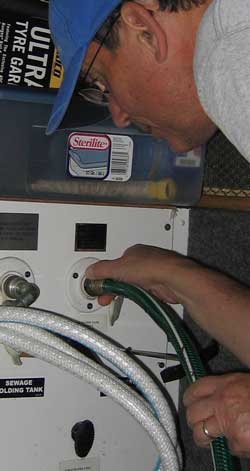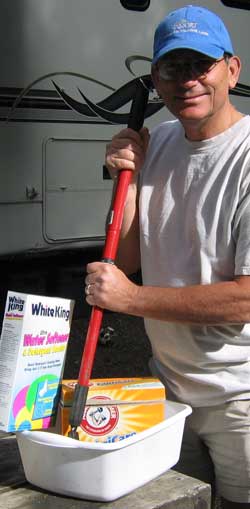Treating RV Waste Water
Holding Tanks
Holding Tanks



this method is simple and works. You can read Mr. Bruni's entire method and his contact information below.
November 5, 2007: When you visit RV rallies whether they are Escapades, or Good Sam rallies, you will find that every individual RV unit has their own favorite method of caring for their holding tanks. There is much controversy over the Charles Bruni method described below. The first thing I will say about it is that I have NEVER used bleach in any of my tanks. The primary reason is that you want healthy bacteria in those tanks and bleach will kill the bacteria. Today I got an email from Bob who made me aware that this page may be misleading. To make myself clear, I have NEVER used bleach in my holding tanks ... I have used powdered water softner and laundry soap mixture but haven't even used that since adding Extreme Vents to my holding tank vents. These force fresh air through the holding tanks which encourages bacteria growth. So we have never put anything into our new Cameo holding tanks and have not suffered from the lack of chemical additives. To be honest, I have never had the Cameo in a warm climate which may encourage odors. If that happens, my plan is to add bacteria enzymes as Bob suggested in his email but the bacteria seems to be doing just fine without adding the enzymes. Another thing I would try is adding sour milk with Acidophilus Culture. To repeat, every RVer has their own method of keep their holding tanks working properly so you can get a thousand different versions. I prefer NOT to use chemicals of any kind to keep the bacteria happy. Perhaps I should add here that we never put toilet paper into the holding tank either so we don't have to worry about TP clogs!
April 21, 2010: One concern I had about recommending no chemicals in the holding tank was that we were hooked up to a sewer system at the time so I could completely rinse my blackwater tank each time I flushed it (about every ten days). I thought I might think differently once I began the boondock lifestyle. Well, it's been nearly a year since we began boondocking and we still use no chemicals in our holding tanks. I DO wash out the graywater holding tank with vinegar every chance I get because it does create a foul odor if I don't but still nothing in the blackwater tank.
Using Water Softener, Laundry Detergent,
and Chlorine Bleach
The Geo Method
By Charles Bruni
cbruni@mindspring.com
Renton, Washington
U.S.A.
RV owners should be concerned with maintaining its wastewater tanks. Problems with wastewater tanks can and should be avoided. Wastewater tank repair is expensive. Due to health concerns, many service facilities will not work on wastewater tanks and lines until the tanks have been completely emptied and sanitized. This may be quite difficult when the tank(s) is in need of repair. So, common sense dictates that the tanks should be kept relatively clean at all times. Additionally, improper use of the wastewater tanks can lead to a build up of solid wastes, which in itself may cause the system to fail.
I've discovered very simple, effective, and inexpensive methods of maintaining my wastewater tanks in a relatively clean condition at all times. I developed these methods myself through my understanding of chemistry, physics, and biology with a smidgen of common sense thrown in for good measure. I also read my RV owner's manual. Although we are not full time RVers we use our fifth wheel camper at least one weekend a month. We never use public bathing and toilet facilities. In other words, our wastewater tanks are fairly heavily used. Since I've met a number of RVers who don't seem to know how to maintain their wastewater tanks I thought many RVers would find my tips useful. If you have not been maintaining your tanks I believe you will be pleasantly surprised the first time you employ these tips. I do these things and they work.
RVs are equipped with waste water HOLDING tanks; NOT septic tanks. Those holding tanks are nothing more than chamber pots. Chamber pots should be cleaned and sanitized after their contents are disposed of. The Geo Method is based on this fact.
1. DUMP A FULL TANK
When you are camping and your RV is connected to a sewer/septic intake, leave the drain valves closed until the tank is full and ready to dump. Dumping a full tank provides a sufficient quantity of water to flush solids from the tank. Leaving the drain valves open allows the water to drain off without flushing out solid waste. That solid waste will collect in the tank(s) and cause problems over time. If your tanks are not full when you are ready to dump them, fill them with fresh water first, and then dump them.
2. DUMP TANKS IN ORDER FROM DIRTIEST TO CLEANEST
In other words, dump the black (commode) water tank first, then dump the galley tank, then dump the bathroom tank. This way you will be flushing out the dirtiest water with progressively cleaner water.
3. USE WATER SOFTENER, DETERGENT, and CHLORINE BLEACH
This stuff is amazing and it works. Buy a couple of boxes of powdered water softener at the grocery store. You'll find it located with or near the laundry detergent products. I prefer Calgon Water Softener because it dissolves quickly in water. Cheaper water softeners work just as well but dissolve more slowly. Dissolve two (2) cups of the water softener in a gallon of hot water. Then, pour the solution down the drain into the empty tank. Use two cups of softener for each wastewater tank in your RV. The tank's drain valve should be closed otherwise the softened water will just drain out. Then use the tank(s) normally until it is full and drain it normally. Add a cup of laundry detergent to the black (commode) water tank at the same time you add water softener. This will help clean the tank. The gray water tanks should already contain soap through normal use.
Water softener makes the solid waste let go from the sides of the tanks. If you've ever taken a shower in softened water you know that after rinsing the soap from your body your skin will feel slick. That's because all the soap rinses away with soft water. Softened water also prevents soap scum from sticking in the tub. Get the connection? With softened water gunk washes away instead of sticking. The same thing applies to your RV's wastewater tanks.
I use a clear plastic elbow connector to attach my sewer drain line to the wastewater outlet on my RV. It allows me to see how well things are progressing during a wastewater dump. Before I began using water softener regularly the black water tank's water was brown, the galley tank's water was brownish, and the bathroom tank's water was white. The first time I added water softener to the tanks the water coming from the black water tank was actually black (not brown) and the kitchen tank's water was also black (not brownish). The bathroom tank's water remained white. That told me that the water softener had actually done what I had intended for it to do and made solid waste, which had been stuck to the interior of the tanks, let go and drain away. I added water softener (and laundry detergent to the black tank) to all the wastewater tanks for the next few dumps to be certain all the solid waste possible had been cleaned away. The wastewater only appeared black on the initial treatment. I now add water softener and detergent to each tank once after every few dumps to maintain the system.
Too little water softener may not be of sufficient concentration to work effectively. Too much water softener will NOT hurt the tanks. So, if the amount you used didn't quite do the job, then use more the next time. Don't forget the laundry detergent.
Occasionally, I pour a half gallon of liquid bleach into each tank to deodorize, sanitize and disinfect them. I add the bleach when the tank is about half full, and then continue to use the tank normally until it is full and ready to dump. I no longer use the blue toilet chemical because it isn't necessary. I have no odors coming from my black water tank. The chlorine bleach kills the bacteria, which is primarily responsible for waste water tank odor. Generic brand liquid bleach is cheap and very effective.
4. USE A WATER FILTER ON YOUR FRESH WATER INTAKE LINE
Most fresh water contains sediment. Sediment will accumulate in your wastewater tanks and your fresh water lines. It also tends to discolor your sinks, tub/shower, and commode. I use the disposable type and have found that they eventually fill up and begin restricting the fresh water flow resulting in low pressure. That's how I know it's time to get a new filter. It works, it's cheap, it avoids problems, do it. When I fill my fresh water tank I attach the filter to the end of the hose and fill the tank with filtered water.
SOME OTHER THOUGHTS
WATER, WATER, WATER - and more water! The Geo Method assumes you are hooked up to a plentiful clean water supply, and that you have access to a sewer. The water softener will make the gunk let go. That's only half the battle. After the gunk lets go it must then be flushed through the relatively small drain opening in the bottom of the tank. That takes water. Lots of water. I use a Flush King (Google it) to make rinsing more effective and faster.
CAUTION should be used when mixing chemicals. All I did when I came up with The Geo Method was use normal laundry products (water softener, laundry detergent, and chlorine bleach) and put them in the holding tanks which already contain water. I was NOT experimenting with chemicals. I simply applied laundry chemicals in normal combination to the waste water tanks. There are chemical products under your kitchen sink, in your laundry room, and in your garage that can injure or kill you when mixed. If you can do your laundry without harming yourself you can successfully employ The Geo Method. Don't go playing around with novel chemical combinations concocted from household products.
What was novel about The Geo Method was not in the combination of chemicals (all household laundry products intended to be used in combination) but in their application in cleaning RV waste water tanks. Common experience, if you've done laundry, tells you The Geo Method is safe. Doing laundry doesn't damage your washing machine, rot out your plumbing, or destroy waste water treatment systems. The Geo Method won't either. However, substituting other cleaning agents may not be safe.
There's nothing special or fragile about the materials used in RV plumbing. RV plumbing materials are made from the same stuff that household plumbing is made from. The problem arises in figuring out how to clean and sanitize the inaccessible interior of a holding tank. Water softener prevents gunk from adhering to the inside of the tanks, detergent removes the dirt, and chlorine bleach kills germs/odors. Soaking gives the chemicals time to work. Agitating the mix by driving down the road helps the process. Think of it this way; you can put some really nasty stuff in your washing maching, yet the inside of the washing maching doesn't get dirty. It stays clean - right? Same goes for your automatic dish washer. The same thing applies to RV holding tanks.
Those people who claim The Geo Method is somehow harmful just plain don't know what they're talking about. Their objections defy common sense and common experience. Anyone who thinks The Geo Method is harmful has a simple soultion available to their simple minded concerns - don't use it. At one time, daily bathing was thought by some to be harmful to one's health, and they argued against it advising others to remain dirty. Those who object to The Geo Method fall into the same category of enlightened thought.
Will The Geo Method work even if most of the time I'm NOT hooked up to water and sewer? YES! Just use common sense. If you dry camp ninety percent of the time just keep water softener and detergent in your tanks (especially the black tank) while you're dry camping. This will keep gunk from sticking to the tanks. When you are hooked up to sewer and water take the opportunity to fill the tanks with fresh water and flush the tanks. Keep flushing them until the water runs clear. I know it works because I've done it.
Never put regular toilet tissue in your RV's black tank. Only use toilet tissue which is approved for RV and/or septic tank use. Regular toilet tissue may eventually dissolve, but not before causing a clog in your black tank.
Occasionally traveling with partially filled wastewater tanks containing softened water and detergent promotes cleaning by agitating the water. The same goes for chlorine bleach.
I believe this process works faster and more efficiently during warm weather. However, I know it works well even during cool/cold weather.
The process works best the longer the water softener and detergent remains in the tanks. So, I don't add water softener during periods of heavy wastewater generation. I wait until I know we won't be generating wastewater quickly so that the softened water remains in the tanks for several days before dumping.
If you have an older RV you may have to use water softener and detergent several times initially to completely clean the tanks of residue.
I add a small amount of chlorine bleach to the fresh water tank twice a year to disinfect and sanitize the fresh water tank and fresh water lines. A weak chlorine bleach solution will not hurt you. However, it certainly makes the water taste bad. When we have chlorine in the fresh water system we use bottled water for drinking and cooking until the chlorine is gone. YES, we drink the filtered water that we have in the fresh water tank. NO, it has never tasted funny or caused any problems.
No, I do NOT do the ice cube thing. The Geo Method works just fine without ice cubes.
My tanks are plastic and my pipes are PVC.
Don't be afraid to use your tanks. Just use common sense about their care and maintenance.
These tips are inexpensive to do. Some of them don't cost anything. You have nothing to lose in trying them and I encourage you to do so. I actually feel a certain amount of pride in the condition and cleanliness of both my waste and fresh water systems. Naturally, these tips make dumping a much more pleasant and sanitary procedure.
If you have odors in any of your water systems these procedures should eliminate them. Odors indicate a sanitary problem and degrade the enjoyment you derive from your RV.
When my RV is parked and not in use I place stoppers in the sink and tub drains. This forces the wastewater tanks to vent through the vent pipes to the outside instead of through the drains into the RV. Water evaporates. Once the drain traps dry out during periods of non-use, nothing is there to prevent gasses (odor) from venting into the camper. Use stoppers when your RV is stored.
Copyright(c)2003-2005 Charles Bruni
_____________________________________________________
Please consider printing this information and posting it on bulletin boards in RV parks and campgrounds you visit. Fellow RVers will benefit from your consideration.
_______________________________________________________________
How sewer and septic systems work - click here
How detergent works - click here
Calgon Water Softener Link - click here